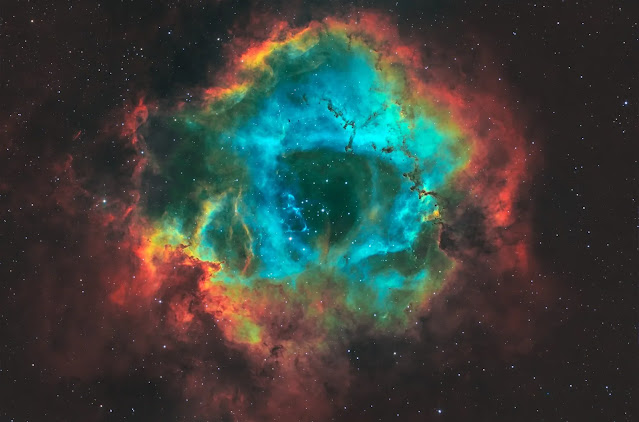Discovering the Rosette Nebula: A Stellar Nursery in the Cosmos 🌹🌌
The Rosette Nebula, a stunning and intricate cosmic structure, is a stellar nursery located in the constellation Monoceros, the Unicorn. This beautiful nebula, resembling a rose in full bloom, is a magnificent example of the wonders of the universe. At CuriousWorlds, we invite you to explore the breathtaking Rosette Nebula and uncover the secrets of its formation and significance.
What is the Rosette Nebula?
The Rosette Nebula (NGC 2237) is a large, circular emission nebula located approximately 5,000 light-years from Earth. Spanning about 130 light-years in diameter, it is part of a larger molecular cloud that also contains the open star cluster NGC 2244. The nebula's striking appearance, with its petal-like structures, is due to the intense radiation and stellar winds from the young, hot stars at its center.
Formation and Structure
Star Formation: The Rosette Nebula is a stellar nursery, a region where new stars are born. The nebula's central cluster, NGC 2244, contains young, massive stars that formed from the surrounding gas and dust.
Emission Nebula: The intense ultraviolet radiation from these young stars ionizes the hydrogen gas in the nebula, causing it to emit light. This process creates the characteristic red and pink hues seen in images of the Rosette Nebula.
Molecular Cloud: Surrounding the nebula is a vast molecular cloud, a cold and dense region of gas and dust. This cloud provides the raw material for star formation and contributes to the complex structure of the nebula.
Significance of the Rosette Nebula
Understanding Star Formation: Studying the Rosette Nebula helps astronomers understand the processes involved in star formation. By observing the interactions between young stars and their environment, scientists can learn more about the lifecycle of stars and the evolution of galaxies.
Astrophysical Laboratory: The nebula serves as a natural laboratory for studying astrophysical phenomena, such as the impact of stellar winds and radiation on surrounding gas and dust.
Observing the Rosette Nebula
Location: The Rosette Nebula is located in the constellation Monoceros, near the border with the constellation Orion. It can be observed from the northern and southern hemispheres during the winter months.
Equipment: While the nebula is faintly visible through binoculars, a small telescope is recommended for better viewing. For astrophotographers, long-exposure imaging can reveal the nebula's intricate details and vibrant colors.
Astrophotography: The Rosette Nebula is a popular target for astrophotographers due to its stunning appearance and relatively large size. Capturing its beauty requires clear skies and proper equipment, including a telescope with a wide field of view and a camera capable of long exposures.
Explore More with CuriousWorlds
At CuriousWorlds, we are dedicated to exploring the wonders of the universe and sharing our discoveries with you. Join our community to stay updated on the latest astronomical findings and delve deeper into the mysteries of the cosmos.
Join the Conversation
Share your thoughts on the Rosette Nebula in the comments below. Have you ever observed this stunning nebula? What do you find most fascinating about star-forming regions in space? We’d love to hear from you!
Keywords:
- Rosette Nebula
- Stellar nursery
- NGC 2237
- Emission nebula
- Star formation
- Monoceros constellation
- Young stars
- Molecular cloud
- Astrophotography
- CuriousWorlds blog




Comments
Post a Comment